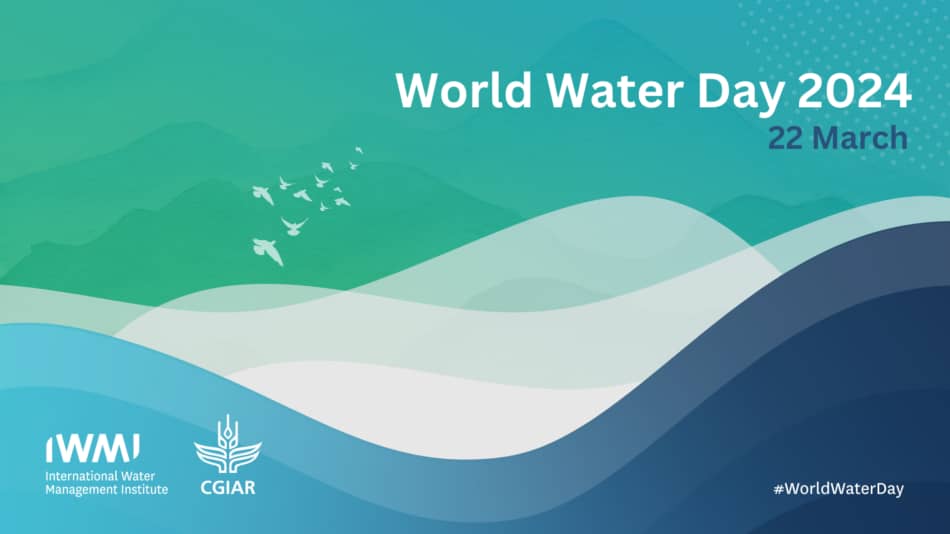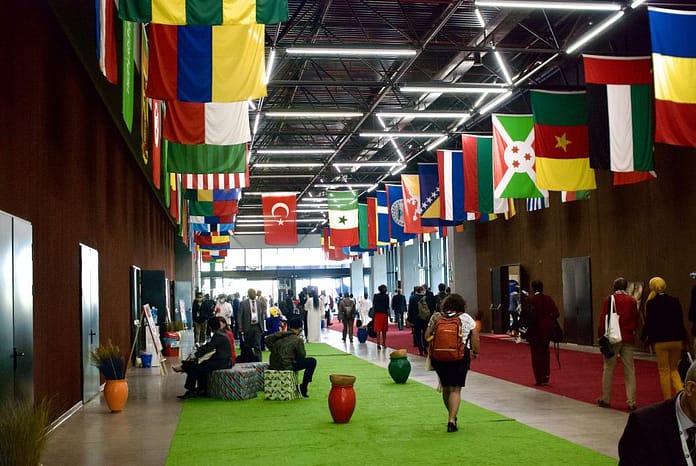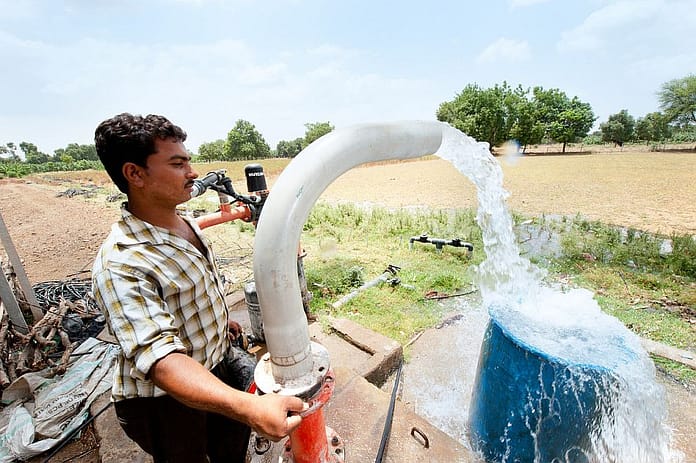Transforming water security is essential for a safe, just, and sustainable future. However, water risks are increasing due to climate impacts, threatening the world’s commitment to ‘leave no one behind.’ We spoke with Mark Smith, Director General of the International Water Management Institute (IWMI), about why water security is a defining challenge for development, and how collective action can accelerate change for water systems.
What are the five wicked water problems that keep you up at night?
Mark Smith: There are five main issues that really worry me: hunger driven by water insecurity, growing risks beyond the 2°C threshold, poverty and exclusion of vulnerable communities, deep uncertainty in the face of future water risks, and the breakdown of ecosystems. As is abundantly clear, our future is hinged on water security. But as stated in the 2021 IPCC report, each incremental degree of warming makes it harder to achieve water security. And poor communities living in the Global South who are most vulnerable to water shocks are at the forefront of climate risks.
Like many others, I am worried for the future of younger generations. But as a member of a research institute focused on water, I am part of a community that is channeling that worry into developing solutions through partnership and collective action with local communities on the ground, their governments and many generous partners to develop water and climate solutions that stick. I draw tremendous hope from our work.
How can advancements in agricultural water management mitigate the risk of hunger for populations facing severe water insecurity?
Mark Smith: In recent years, IWMI, along with the CGIAR network and our partners, has developed and tested various innovative farming techniques to better manage water for agriculture. One notable example is solar irrigation. In Ghana, Ethiopia, and Mali, we’ve collaborated with farmers and the private sector to make solar irrigation more affordable and accessible, especially for smallholder farmers and marginalized groups like women and youth. One key issue is also to ensure that water is pumped within the limits of sustainability, leaving enough water to support local ecosystems and the communities depending on them.
However, the key challenge lies in scaling these solutions. By working closely with all stakeholders, we’ve identified and developed “best-fit” innovation bundles that are not only affordable and accessible but also tailored to local contexts. The results from these interventions are promising, as they contribute to strengthening water security and increasing food production sustainably.
Similarly, in north-central Sri Lanka, we are implementing climate-smart solutions that combine climate information, resilient seeds, and weather index insurance. These efforts empower farmers to withstand water-related shocks such as droughts and floods. And it is a good entry point for private sector partners too, to be part of these innovative solutions through the improvement of value chains and provision of solar pumps that help to sustainably manage agricultural water.
What are the most effective strategies for adapting to increased water demand and water scarcity risks in the face of climate change, particularly beyond the 2°C threshold?
Mark Smith: Just last month, we passed a significant warming threshold, and already we have felt the consequences: longer heatwaves, floods, and droughts. No part of the world has been immune to these changes in the water cycle. Now, we can only imagine the even greater impacts beyond 2°C. There is a real concern that climate change may outstrip our ability to adapt, especially in the most vulnerable regions. Ensuring future water security hinges on both adapting to climate change and mitigating its effects. This is why, at IWMI, our research takes a holistic and integrated approach to managing water systems.
In Morocco, Jordan, and Lebanon, we receive support from USAID to collaborate on national plans for disaster risk reduction. Together with these governments, we are developing Drought Adaptation Plans to better manage the effects of drought on water and food security. Additionally, through the Al Murunah project grounded in the MENA region, we are exploring nature-based solutions for water and agricultural water management. Our focus remains on empowering and engaging local communities throughout these initiatives.
How can empowering marginalized communities through water access lead to broader socio-economic development and gender equality?
Mark Smith: Improving water access for marginalized communities and vulnerable people has far-reaching benefits for both socio-economic development, inclusion and gender equality. Additionally, empowering women in water management not only challenges traditional gender roles but also fosters their leadership and economic opportunities.
For instance, in Central Asia, our researchers studied the impacts of male outmigration on women’s access to water resources. They found that when the men leave, women are often left with the responsibility of managing their household farm – on which they depend for food and livelihoods. However, because of social and cultural norms, they also often lack the information, training, financing and tools they need to irrigate their farms. From this stemmed many projects that facilitated access to water, technologies and knowledge for women, thereby enhancing food security and promoting social inclusion.
How can collective action between scientists, policymakers, and stakeholders enhance our understanding of future water risks?
Mark Smith: When discussing this topic, it’s essential to address the important challenge of water data fragmentation. While there have been significant advancements in water data science, a critical issue persists: the disconnect between this data and the growing challenges in governance. This gap worsens the uncertainty surrounding water risks. To effectively enhance water security, we must bridge this divide by ensuring that data analytics and information applications align with the priorities and needs of the Global South.
IWMI is actively harnessing water data science and AI tools to address information gaps. One significant initiative involves water accounting for both present and future climates, as well as forecasting demand for food, energy, and ecosystems. Since 2020, IWMI’s Digital Innovations for Water Secure Africa (DIWASA) project has been mapping the continent’s water landscape. By coupling weather forecasting with Earth observation data from satellites, this project is closing critical water data gaps to provide African decisionmakers with the information they need to better adapt to the impacts of climate change. Cutting-edge innovations like remote sensing, cloud computing, and machine learning are further enhancing the accessibility of water data across Africa. Thanks to support from the Helmsley Charitable Trust, this work is now being expanded to increase water data availability in Burkina Faso, Ethiopia, Ghana, and Zambia.
However, addressing data and information gaps is just one piece of the puzzle in bridging the divide between governance structures, scientific findings, and policy implementation. It is imperative to work in collective action with stakeholders at different scales to develop sustainable solutions tailored to the specific needs and contexts of different countries, regions, and communities. Collective action is crucial to achieve a significant shift towards a safe, just, and sustainable future that leaves no one behind.
How can stakeholders work together to develop and promote best practices for protecting water and environmental resources?
Mark Smith: In 2021, the FAO issued a stark warning: ecosystems are at a breaking point. Our rivers are a prime example of this fact. As the Earth’s climate heats up and the demand for freshwater grows, competition for water intensifies, limiting its availability for ecosystem services, and the communities that depend on them for their primary needs and livelihoods. In response, IWMI and its partners are developing analytical models to monitor and protect river resources. One valuable tool in this effort is the environmental flows (e-flows) calculator. We’ve effectively used this calculator in the Limpopo River Basin and policymakers in Nepal have also adopted it for irrigation planning. These examples highlight our success in bridging the gap between scientific research and policy implementation, showcasing the power of collaborative endeavors in sustainably managing and conserving water resources.
Our water systems are complex and shaped by many physical, ecological, social, economic and political influences. Progress will depend on our ability to accelerate this agenda and collectively lift barriers caused by lack of data and information, poor water governance, social exclusion, deficiencies in knowledge and skills, and lack of finance. To tackle these issues, we must work in partnership to deliver and scale sustainable solutions across food, land, energy and ecosystems that address future water risks and existing social and gender inequalities. We must converge on collective action for a safe, just and sustainable future for all.














